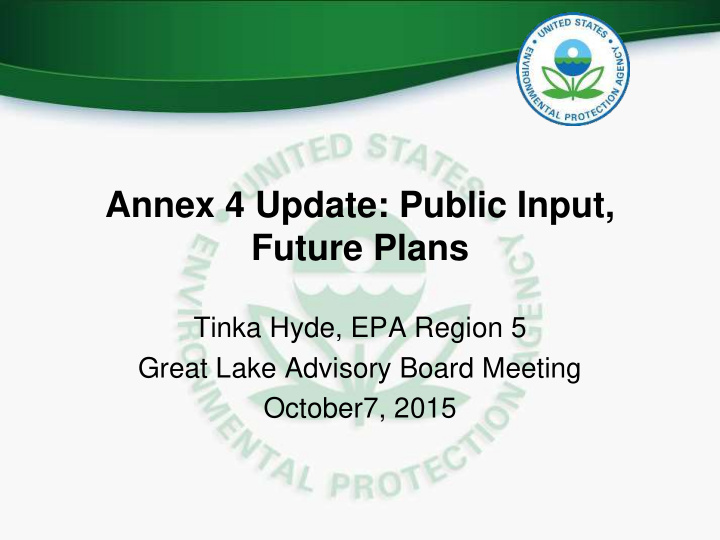



Annex 4 Update: Public Input, Future Plans Tinka Hyde, EPA Region 5 Great Lake Advisory Board Meeting October7, 2015
Outline • GLWQA Nutrients Annex – Recommended Targets – a brief reminder • Input from Consultation • Next Steps – Consider Comments & Finalize Targets – Adaptive management – Domestic action plans 2
Nutrients Annex In cooperation and consultation with stakeholders – By 2016 and starting with Lake Erie • Review, revise and/or develop concentration and loadings objectives for offshore and nearshore waters of Great Lakes • Establish allocations by country • Establish load reduction targets for priority watersheds that have significant or localized impact By 2018 • Develop Domestic Action Plans • Implement P reduction programs 3
Proposed Bi-National Phosphorus Load Reduction Targets Western Basin of Lake Erie Central Basin of Lake Erie Lake Ecosystem Objectives Great Lakes Water Quality Agreement Annex 4, Section B Minimize the extent of hypoxic zones in the 40% reduction in total phosphorus entering the Western Basin and Central Basin of Lake Erie – from the United States and Waters of the Great Lakes associated with excessive phosphorus loading, with particular from Canada - to achieve 6000 MT Central Basin load emphasis on Lake Erie Maintain algal species consistent with healthy 40% reduction in spring total and soluble reactive phosphorus aquatic ecosystems in the nearshore Waters of loads from the following watersheds where localized algae is a the Great Lakes problem: Thames River - Canada Sandusky River - US Huron River, OH – US Maumee River - US River Raisin - US Portage River - US Toussaint Creek - US Leamington Tributaries – Canada Maintain cyanobacteria biomass at levels that 40 % reduction in spring total N/A do not produce concentrations of toxins that and soluble reactive pose a threat to human or ecosystem health in phosphorus loads from the the Waters of the Great Lakes Maumee River (U.S.) 4 August 18, 2015 Western Lake Erie Basin Partnership Meeting
August 18, 2015 Western Lake Erie Basin Partnership Meeting 5
Consultation Overview • Direct consultation (in-person or webinar) • Binational and Domestic engagement • Feedback Received – Technical concerns – Ideas for action 6
Types of Feedback Received • General support for the 40% reduction targets and our process • Some concerns regarding: – Baseline & measuring progress – Applying 40% to all priority watersheds (some may need more/less) – Perceived lack of target for Detroit River – Lack of Eastern basin target for Cladophora – How to account for uncertainty & set realistic goals – Climate change 7
Ideas for Action • Stakeholder collaboration in development of domestic action plans • Focus on BMPs that reduce DRP • Strategic monitoring & implementation • Comprehensive assessment of sources • Identify load allocations by state/province 8 September 16, 2015 Annex 4 Subcommittee Meeting
Adaptive Management • Implementation • Enhanced Monitoring • Research & Modelling • Evaluate • Adjust Diagram from U.S. Department of the Interior 9 August 18, 2015 Western Lake Erie Basin Partnership Meeting
Next Steps • Consider input received during consultation • Finalize targets by February 2016 to achieve the time bounded commitment • Begin work on – Binational P Reduction Strategy – Domestic Action Plans – Lake Ontario 10 August 18, 2015 Western Lake Erie Basin Partnership Meeting
Nutrients Annex Subcommittee Ministry of the Environment and Climate Change 11
Recommend
More recommend